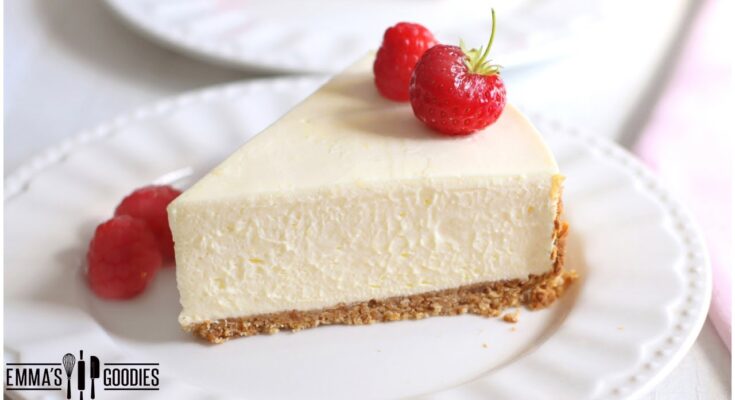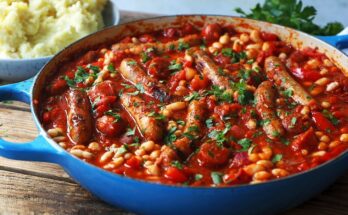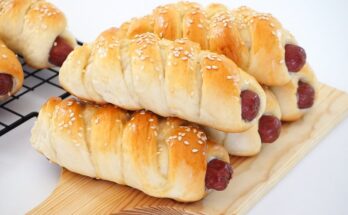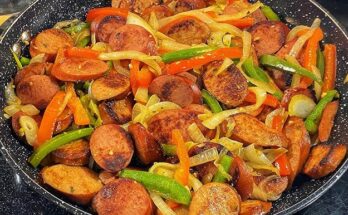Cheesecake Recipe: There’s something undeniably special about cheesecake. Rich, creamy, and indulgent, it’s a dessert that satisfies a wide range of cravings. Whether it’s for a birthday party, a special family dinner, or just a weekend treat, cheesecake is always a crowd-pleaser. What makes it even better is the variety of styles—from the dense New York version to the light and airy Japanese cheesecake. No matter what your taste preferences are, mastering a basic cheesecake recipe will open the door to endless dessert possibilities.
Ready to make your own perfect cheesecake? Follow this step-by-step guide, and you’ll be serving up a dessert that will leave everyone asking for seconds.
Ingredients for the Cheesecake
Before we dive into the steps, let’s talk ingredients. Here’s what you’ll need to make a classic cheesecake:
For the Crust:
- 2 cups of graham cracker crumbs
- ½ cup of unsalted butter, melted
- ¼ cup of sugar
For the Filling:
- 4 (8 oz) packages of cream cheese, softened
- 1 cup of granulated sugar
- 4 large eggs
- 1 cup of sour cream
- 2 teaspoons of vanilla extract
- 1 tablespoon of lemon juice (optional for a slight tang)
Optional Toppings:
- Fresh berries
- Whipped cream
- Chocolate drizzle
- Caramel sauce
Tools You’ll Need
- Springform pan (9-inch recommended)
- Mixing bowls
- Electric mixer (hand or stand)
- Spatula
- Measuring cups and spoons
- Aluminum foil (for water bath)
- Baking tray
Step 1: Preparing the Crust
The crust is the foundation of your cheesecake, and getting it right sets the tone for the entire dessert.
- Crush your graham crackers if you’re starting with whole crackers. You can do this in a food processor or by placing them in a zip-top bag and crushing them with a rolling pin.
- In a bowl, combine the graham cracker crumbs, melted butter, and sugar. Mix until the crumbs are evenly coated and moist.
- Press the mixture firmly into the bottom of a springform pan. Use the bottom of a glass to pack it tightly for a sturdy crust.
- Bake the crust at 350°F (175°C) for about 10 minutes, then let it cool while you prepare the filling.
Step 2: Making the Cheesecake Filling
A smooth, lump-free filling is the secret to a perfect cheesecake.
- In a large mixing bowl, beat the cream cheese and sugar together on medium speed until smooth and creamy. This should take about 2-3 minutes.
- Add the sour cream and vanilla extract, continuing to beat until fully combined.
- Add the eggs one at a time, mixing on low speed after each addition. This helps prevent too much air from getting into the batter, which can cause cracks during baking.
- Scrape down the sides of the bowl to ensure everything is fully incorporated.
Step 3: Adding Flavor to Your Cheesecake
Classic cheesecakes are flavored with vanilla, but you can get creative!
- For a lemony twist, add 1 tablespoon of lemon zest and 2 tablespoons of lemon juice.
- For a chocolate cheesecake, melt 8 oz of dark chocolate and fold it into the batter before baking.
- For caramel lovers, drizzle caramel sauce over the filling before baking.
Step 4: Baking Your Cheesecake
The baking process is where the magic happens, but it’s also where mistakes like cracks can occur.
- Wrap the springform pan in two layers of aluminum foil to prevent water from the water bath leaking in.
- Place the springform pan in a large roasting pan and pour hot water into the roasting pan, about halfway up the sides of the springform pan.
- Bake at 325°F (160°C) for about 60-70 minutes. The cheesecake should be set but still slightly jiggly in the center.
- Turn off the oven and let the cheesecake sit in the residual heat for 1 hour. This helps to prevent sudden temperature changes, which can cause cracks.
Step 5: Cooling the Cheesecake
Cooling the cheesecake slowly is critical to its texture and appearance.
- Remove the cheesecake from the oven and water bath.
- Run a knife around the edges to loosen the cake and prevent cracks.
- Let the cheesecake cool on a wire rack for an hour before transferring it to the fridge.
Step 6: Chilling the Cheesecake
Once cooled, cover the cheesecake and refrigerate it for at least 4 hours, but overnight is best. This helps the flavors meld together, and the texture becomes perfect for slicing.
Step 7: Decorating Your Cheesecake
Now comes the fun part—decorating!
- Top with fresh berries for a burst of color and flavor.
- Add a drizzle of caramel or chocolate for extra indulgence.
- Sprinkle crushed cookies or nuts for a bit of crunch.
Cheesecake Variations
Once you’ve mastered the basic recipe, try these variations:
- New York Style Cheesecake: Thicker and richer, typically with a denser texture.
- No-Bake Cheesecake: A lighter, creamier version that sets in the fridge without the need for baking.
- Gluten-Free Cheesecake: Use almond flour or gluten-free cookies for the crust.
Troubleshooting Common Issues
- Cracked Cheesecake: This is usually due to overbaking or cooling too quickly. Use a water bath and cool gradually.
- Soggy Crust: Make sure to bake the crust before adding the filling, and wrap the pan tightly when using a water bath.
- Overbaked Cheesecake: The center should still jiggle slightly when you turn off the oven.
Serving Suggestions
- For clean slices, use a sharp knife dipped in hot water, wiping it clean between cuts.
- Pair cheesecake with coffee, tea, or even a dessert wine for an elevated experience.
Storage Tips
- In the fridge: Cheesecake can be stored in an airtight container for up to 5 days.
- In the freezer: Wrap slices tightly in plastic wrap and aluminum foil. Freeze for up to 2 months and thaw in the fridge before serving.
FAQs about Cheesecake Recipe
What ingredients do I need for a basic cheesecake?
For a basic cheesecake, you’ll need cream cheese, granulated sugar, eggs, vanilla extract, and a crust made from crushed graham crackers and melted butter. Some recipes may also call for sour cream or lemon juice to enhance the flavor.
How long does it take to make a cheesecake?
Preparing a cheesecake typically takes about 20 minutes of active preparation time and around 50 minutes to bake. It’s important to allow the cheesecake to cool in the oven gradually and then chill it in the refrigerator for at least 4 hours, or overnight, to achieve the perfect texture.
Can I make cheesecake without a springform pan?
Yes, you can use a regular cake pan lined with parchment paper or a pie dish for baking cheesecake. However, a springform pan is preferred because it allows for easy removal of the cheesecake without damaging its structure.
Why did my cheesecake crack?
Cracks can occur if the cheesecake is overbaked or if there are sudden temperature changes. To prevent this, bake the cheesecake in a water bath and avoid opening the oven door frequently. Let the cheesecake cool in the oven slowly before transferring it to the fridge.
Can I freeze cheesecake?
Absolutely! Cheesecake freezes well. Wrap it tightly in plastic wrap and then in foil. It can be stored in the freezer for up to 3 months. Thaw overnight in the refrigerator before serving.
Is there a dairy-free version of cheesecake?
Yes, you can make a dairy-free cheesecake using plant-based cream cheese and a dairy-free sour cream alternative. These ingredients are available in most grocery stores and can be used in equal quantities to their dairy counterparts.
What toppings go well with cheesecake?
Cheesecake is versatile and goes well with a variety of toppings. Popular choices include fresh berries, fruit compote, chocolate ganache, caramel sauce, or simply a dusting of powdered sugar.
Conclusion
To sum up, mastering the art of cheesecake preparation is both rewarding and enjoyable. By following the essential steps outlined, from selecting quality ingredients to perfecting the baking process, you can ensure a delectably smooth and rich result every time.
Cheesecake is wonderfully versatile, allowing for endless creativity in flavors and toppings. Whether you prefer the classic New York style or are curious to experiment with something more adventurous like a matcha or pumpkin spice variation, each version offers its unique charm and taste.
So, why not explore these delightful variations? Dive into the world of cheesecake making today and discover your favorite!
References
For those interested in delving deeper into the art of cheesecake making or seeking additional validation for the techniques and ingredients mentioned in our recipe, the following resources are highly recommended. These reputable sources offer extensive insights and further information that can enhance your baking skills:
- The New York Times Cooking Section: Explore a variety of cheesecake recipes that include tips and tricks from professional chefs. Visit their cheesecake section here.
- AllRecipes Cheesecake Guide: Offers comprehensive step-by-step instructions and user reviews on different cheesecake recipes, which can be especially helpful for home bakers. Check out their guide.
- Epicurious Recipe Collection: This collection features innovative cheesecake recipes alongside traditional favorites, providing a broad spectrum of options for enthusiasts. Find your perfect recipe on Epicurious.
- Food Network’s Cheesecake Recipes: Food Network provides recipes from famous chefs and cooking shows, giving readers a chance to create restaurant-quality desserts at home. Explore their recipes here.
- Serious Eats – The Science of Cheesecake: For those interested in the technical aspects of cheesecake preparation, Serious Eats offers a deep dive into the science behind the perfect cheesecake. Learn more about the science of cheesecake.
These sources are excellent for bakers of all levels to explore additional recipes and gather more information about the delightful world of cheesecakes.



